Comprehensive Report: Project Management and IS Project Quality
VerifiedAdded on 2023/06/12
|10
|2173
|219
Report
AI Summary
This report provides a comprehensive overview of project management, with a specific focus on improving the quality of Information Systems (IS) projects. It identifies key threats such as confidentiality breaches, integrity loss, and availability issues, and discusses the importance of risk management and asset protection. The report also assesses the value and impact of IS project management, considering legal issues like risk insurance and contract interpretation, as well as cultural differences within global teams. Furthermore, it outlines the core project processes—initiating, planning, executing, controlling, and closing—and highlights the outputs of the closing process, including final product transition and updates to organizational process assets. The document emphasizes the significance of adhering to project plans, managing budgets, and addressing potential challenges to ensure successful project completion.
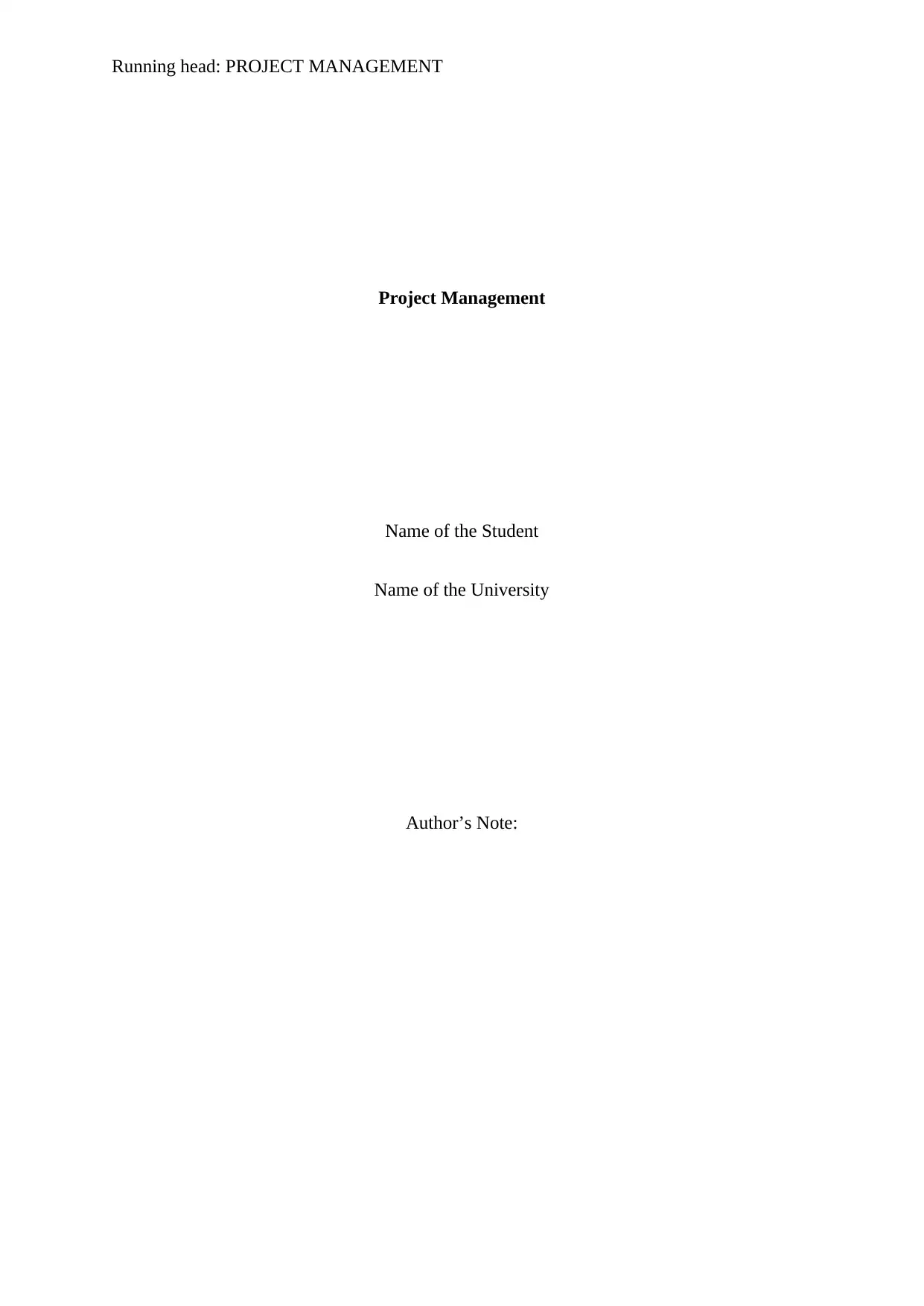
Running head: PROJECT MANAGEMENT
Project Management
Name of the Student
Name of the University
Author’s Note:
Project Management
Name of the Student
Name of the University
Author’s Note:
Paraphrase This Document
Need a fresh take? Get an instant paraphrase of this document with our AI Paraphraser
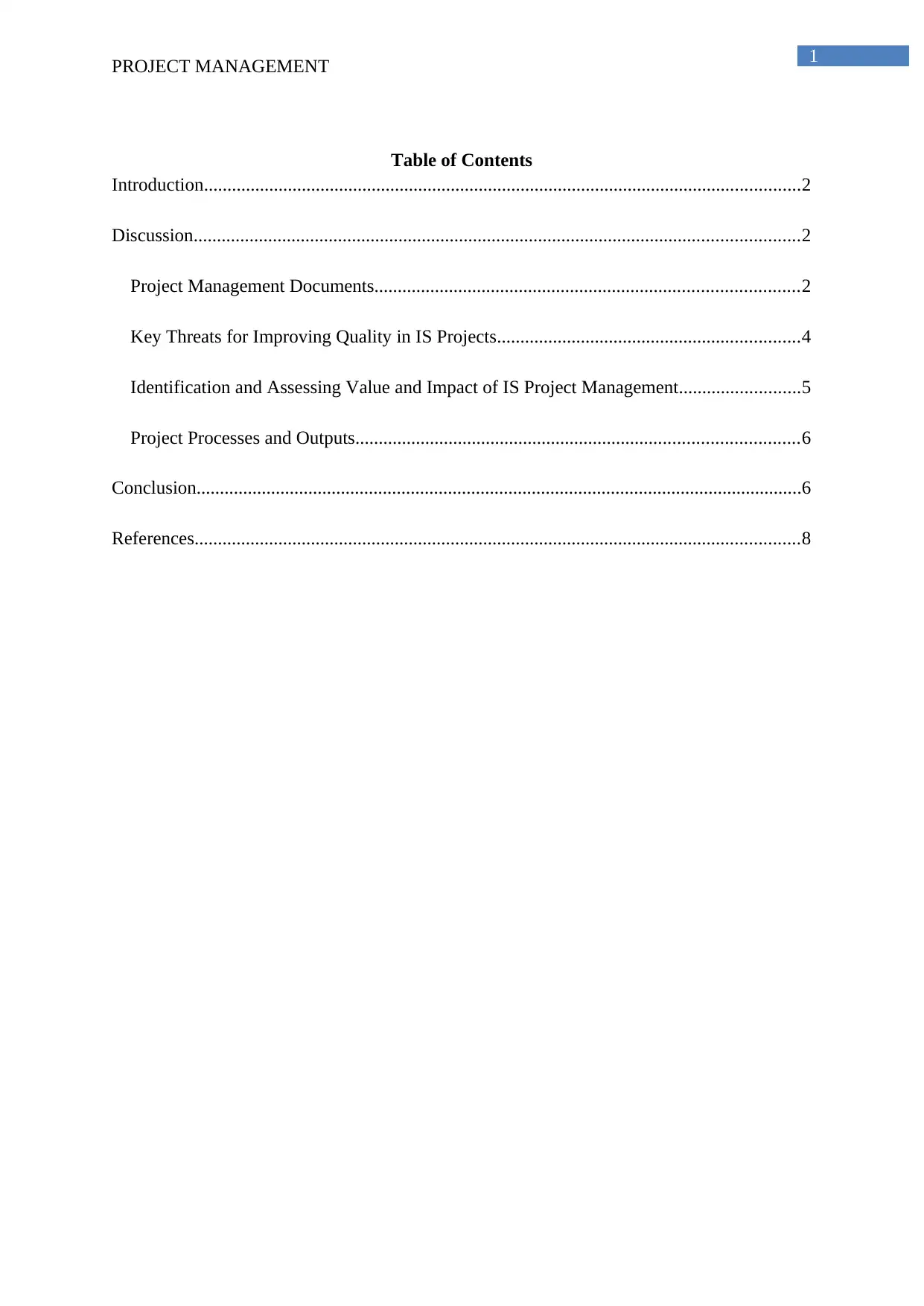
1
PROJECT MANAGEMENT
Table of Contents
Introduction................................................................................................................................2
Discussion..................................................................................................................................2
Project Management Documents...........................................................................................2
Key Threats for Improving Quality in IS Projects.................................................................4
Identification and Assessing Value and Impact of IS Project Management..........................5
Project Processes and Outputs...............................................................................................6
Conclusion..................................................................................................................................6
References..................................................................................................................................8
PROJECT MANAGEMENT
Table of Contents
Introduction................................................................................................................................2
Discussion..................................................................................................................................2
Project Management Documents...........................................................................................2
Key Threats for Improving Quality in IS Projects.................................................................4
Identification and Assessing Value and Impact of IS Project Management..........................5
Project Processes and Outputs...............................................................................................6
Conclusion..................................................................................................................................6
References..................................................................................................................................8
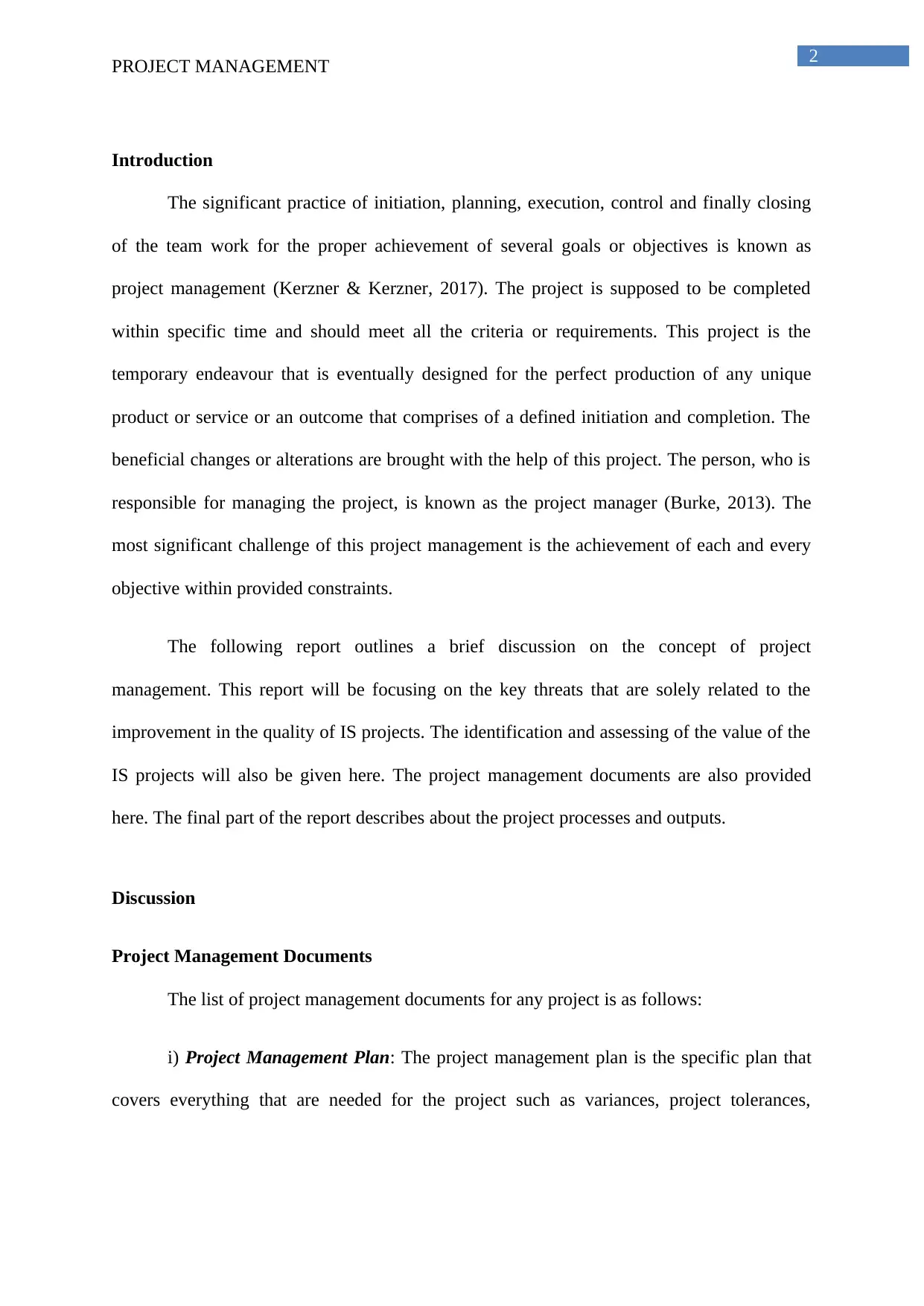
2
PROJECT MANAGEMENT
Introduction
The significant practice of initiation, planning, execution, control and finally closing
of the team work for the proper achievement of several goals or objectives is known as
project management (Kerzner & Kerzner, 2017). The project is supposed to be completed
within specific time and should meet all the criteria or requirements. This project is the
temporary endeavour that is eventually designed for the perfect production of any unique
product or service or an outcome that comprises of a defined initiation and completion. The
beneficial changes or alterations are brought with the help of this project. The person, who is
responsible for managing the project, is known as the project manager (Burke, 2013). The
most significant challenge of this project management is the achievement of each and every
objective within provided constraints.
The following report outlines a brief discussion on the concept of project
management. This report will be focusing on the key threats that are solely related to the
improvement in the quality of IS projects. The identification and assessing of the value of the
IS projects will also be given here. The project management documents are also provided
here. The final part of the report describes about the project processes and outputs.
Discussion
Project Management Documents
The list of project management documents for any project is as follows:
i) Project Management Plan: The project management plan is the specific plan that
covers everything that are needed for the project such as variances, project tolerances,
PROJECT MANAGEMENT
Introduction
The significant practice of initiation, planning, execution, control and finally closing
of the team work for the proper achievement of several goals or objectives is known as
project management (Kerzner & Kerzner, 2017). The project is supposed to be completed
within specific time and should meet all the criteria or requirements. This project is the
temporary endeavour that is eventually designed for the perfect production of any unique
product or service or an outcome that comprises of a defined initiation and completion. The
beneficial changes or alterations are brought with the help of this project. The person, who is
responsible for managing the project, is known as the project manager (Burke, 2013). The
most significant challenge of this project management is the achievement of each and every
objective within provided constraints.
The following report outlines a brief discussion on the concept of project
management. This report will be focusing on the key threats that are solely related to the
improvement in the quality of IS projects. The identification and assessing of the value of the
IS projects will also be given here. The project management documents are also provided
here. The final part of the report describes about the project processes and outputs.
Discussion
Project Management Documents
The list of project management documents for any project is as follows:
i) Project Management Plan: The project management plan is the specific plan that
covers everything that are needed for the project such as variances, project tolerances,
⊘ This is a preview!⊘
Do you want full access?
Subscribe today to unlock all pages.

Trusted by 1+ million students worldwide
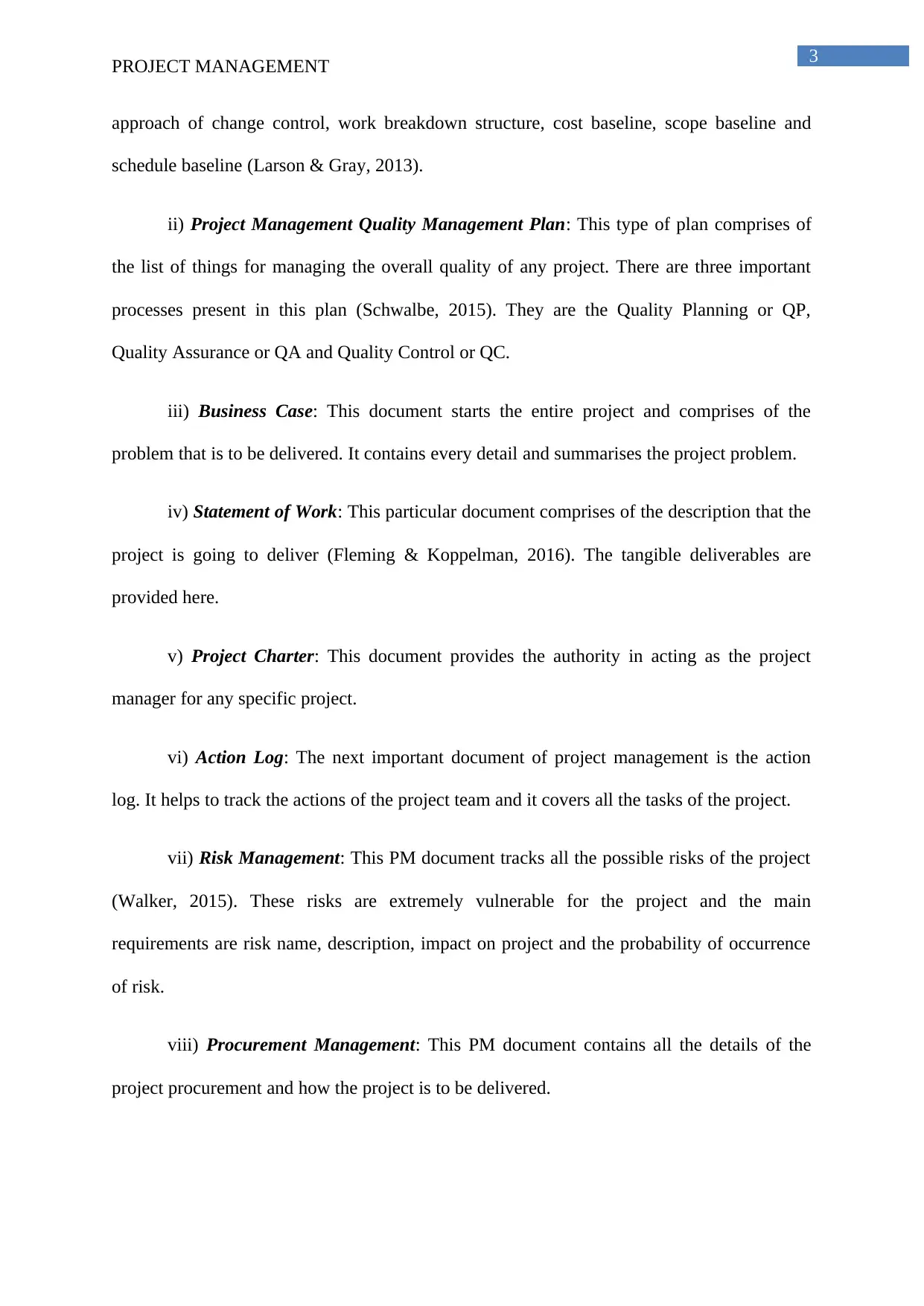
3
PROJECT MANAGEMENT
approach of change control, work breakdown structure, cost baseline, scope baseline and
schedule baseline (Larson & Gray, 2013).
ii) Project Management Quality Management Plan: This type of plan comprises of
the list of things for managing the overall quality of any project. There are three important
processes present in this plan (Schwalbe, 2015). They are the Quality Planning or QP,
Quality Assurance or QA and Quality Control or QC.
iii) Business Case: This document starts the entire project and comprises of the
problem that is to be delivered. It contains every detail and summarises the project problem.
iv) Statement of Work: This particular document comprises of the description that the
project is going to deliver (Fleming & Koppelman, 2016). The tangible deliverables are
provided here.
v) Project Charter: This document provides the authority in acting as the project
manager for any specific project.
vi) Action Log: The next important document of project management is the action
log. It helps to track the actions of the project team and it covers all the tasks of the project.
vii) Risk Management: This PM document tracks all the possible risks of the project
(Walker, 2015). These risks are extremely vulnerable for the project and the main
requirements are risk name, description, impact on project and the probability of occurrence
of risk.
viii) Procurement Management: This PM document contains all the details of the
project procurement and how the project is to be delivered.
PROJECT MANAGEMENT
approach of change control, work breakdown structure, cost baseline, scope baseline and
schedule baseline (Larson & Gray, 2013).
ii) Project Management Quality Management Plan: This type of plan comprises of
the list of things for managing the overall quality of any project. There are three important
processes present in this plan (Schwalbe, 2015). They are the Quality Planning or QP,
Quality Assurance or QA and Quality Control or QC.
iii) Business Case: This document starts the entire project and comprises of the
problem that is to be delivered. It contains every detail and summarises the project problem.
iv) Statement of Work: This particular document comprises of the description that the
project is going to deliver (Fleming & Koppelman, 2016). The tangible deliverables are
provided here.
v) Project Charter: This document provides the authority in acting as the project
manager for any specific project.
vi) Action Log: The next important document of project management is the action
log. It helps to track the actions of the project team and it covers all the tasks of the project.
vii) Risk Management: This PM document tracks all the possible risks of the project
(Walker, 2015). These risks are extremely vulnerable for the project and the main
requirements are risk name, description, impact on project and the probability of occurrence
of risk.
viii) Procurement Management: This PM document contains all the details of the
project procurement and how the project is to be delivered.
Paraphrase This Document
Need a fresh take? Get an instant paraphrase of this document with our AI Paraphraser
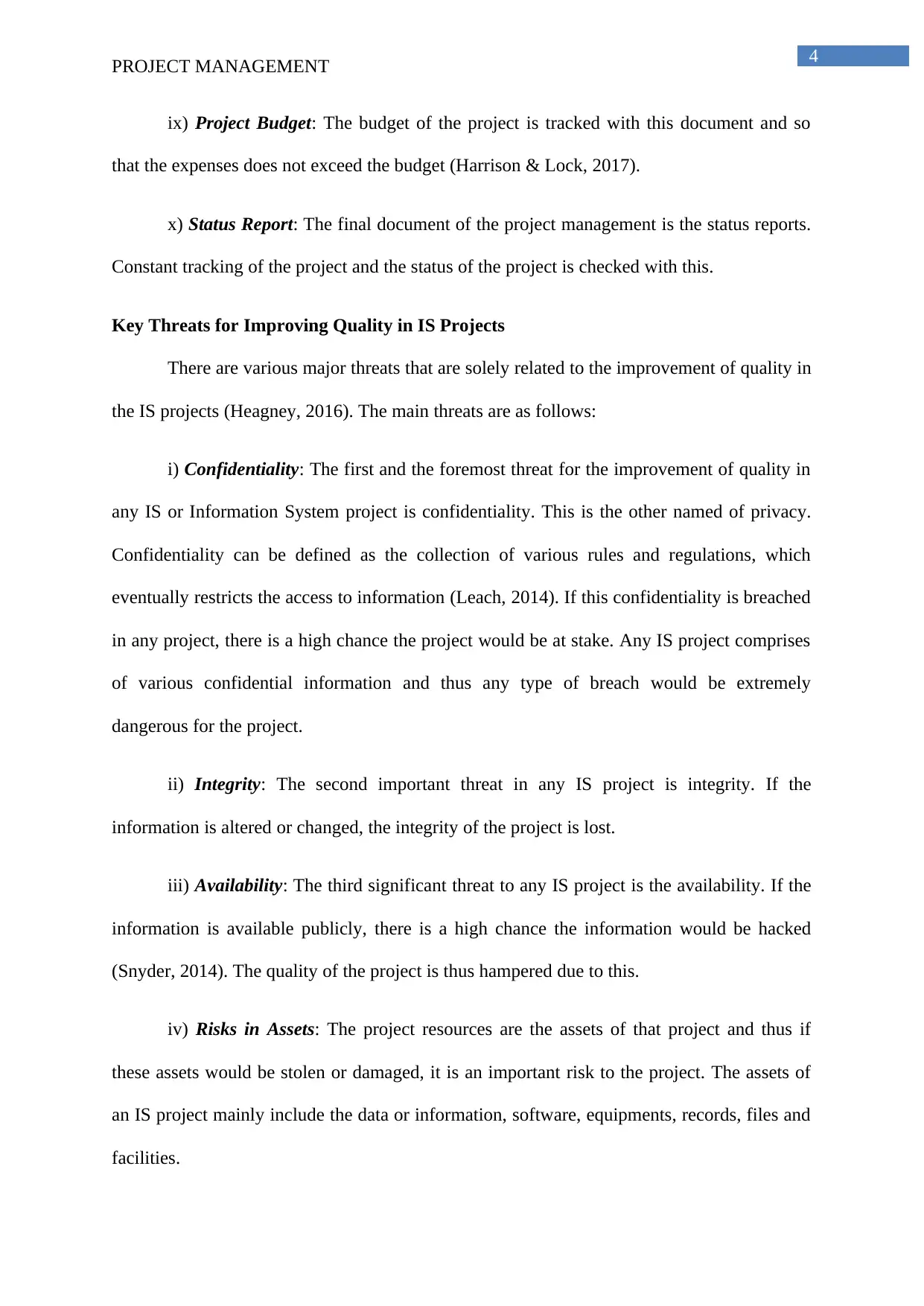
4
PROJECT MANAGEMENT
ix) Project Budget: The budget of the project is tracked with this document and so
that the expenses does not exceed the budget (Harrison & Lock, 2017).
x) Status Report: The final document of the project management is the status reports.
Constant tracking of the project and the status of the project is checked with this.
Key Threats for Improving Quality in IS Projects
There are various major threats that are solely related to the improvement of quality in
the IS projects (Heagney, 2016). The main threats are as follows:
i) Confidentiality: The first and the foremost threat for the improvement of quality in
any IS or Information System project is confidentiality. This is the other named of privacy.
Confidentiality can be defined as the collection of various rules and regulations, which
eventually restricts the access to information (Leach, 2014). If this confidentiality is breached
in any project, there is a high chance the project would be at stake. Any IS project comprises
of various confidential information and thus any type of breach would be extremely
dangerous for the project.
ii) Integrity: The second important threat in any IS project is integrity. If the
information is altered or changed, the integrity of the project is lost.
iii) Availability: The third significant threat to any IS project is the availability. If the
information is available publicly, there is a high chance the information would be hacked
(Snyder, 2014). The quality of the project is thus hampered due to this.
iv) Risks in Assets: The project resources are the assets of that project and thus if
these assets would be stolen or damaged, it is an important risk to the project. The assets of
an IS project mainly include the data or information, software, equipments, records, files and
facilities.
PROJECT MANAGEMENT
ix) Project Budget: The budget of the project is tracked with this document and so
that the expenses does not exceed the budget (Harrison & Lock, 2017).
x) Status Report: The final document of the project management is the status reports.
Constant tracking of the project and the status of the project is checked with this.
Key Threats for Improving Quality in IS Projects
There are various major threats that are solely related to the improvement of quality in
the IS projects (Heagney, 2016). The main threats are as follows:
i) Confidentiality: The first and the foremost threat for the improvement of quality in
any IS or Information System project is confidentiality. This is the other named of privacy.
Confidentiality can be defined as the collection of various rules and regulations, which
eventually restricts the access to information (Leach, 2014). If this confidentiality is breached
in any project, there is a high chance the project would be at stake. Any IS project comprises
of various confidential information and thus any type of breach would be extremely
dangerous for the project.
ii) Integrity: The second important threat in any IS project is integrity. If the
information is altered or changed, the integrity of the project is lost.
iii) Availability: The third significant threat to any IS project is the availability. If the
information is available publicly, there is a high chance the information would be hacked
(Snyder, 2014). The quality of the project is thus hampered due to this.
iv) Risks in Assets: The project resources are the assets of that project and thus if
these assets would be stolen or damaged, it is an important risk to the project. The assets of
an IS project mainly include the data or information, software, equipments, records, files and
facilities.
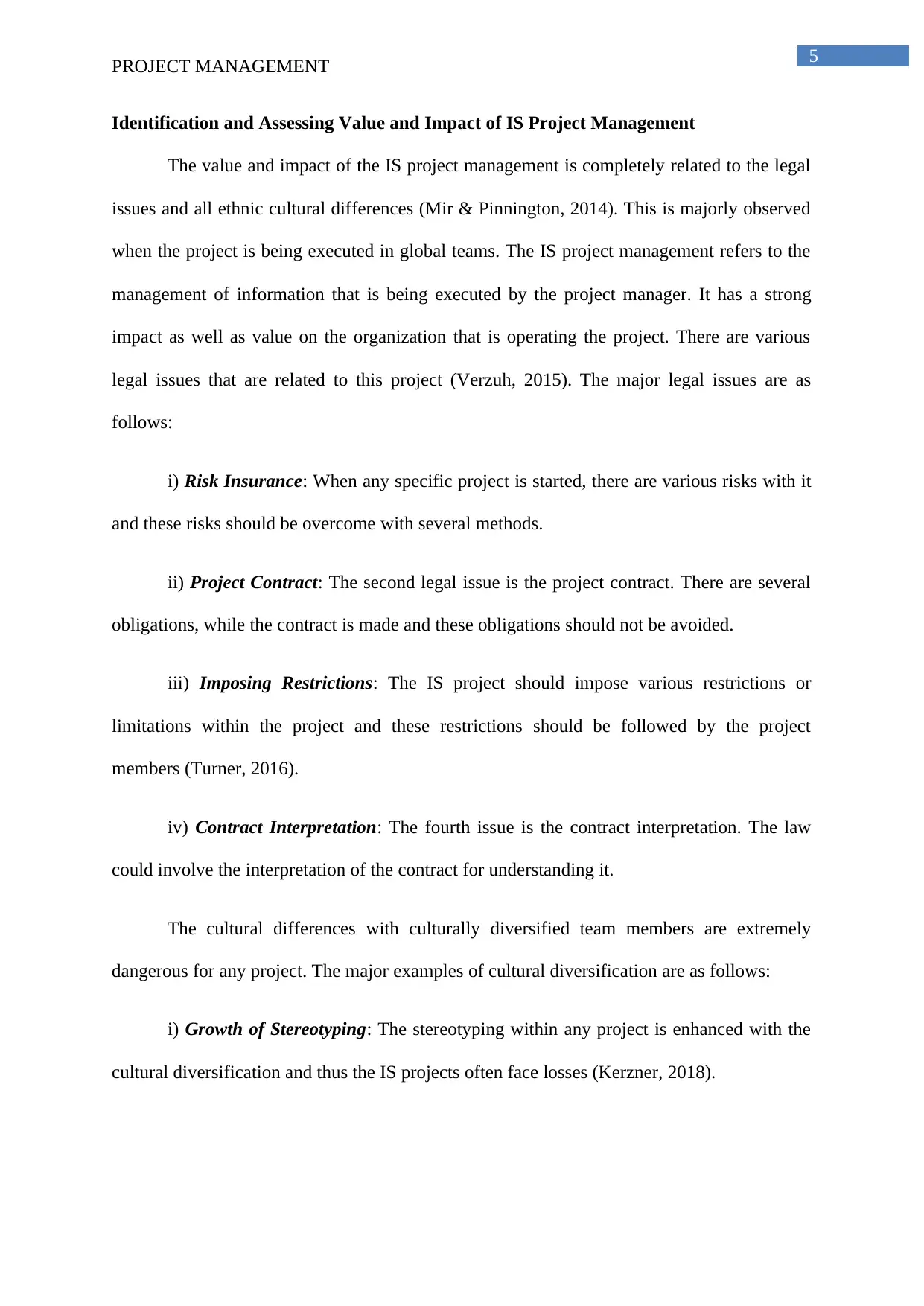
5
PROJECT MANAGEMENT
Identification and Assessing Value and Impact of IS Project Management
The value and impact of the IS project management is completely related to the legal
issues and all ethnic cultural differences (Mir & Pinnington, 2014). This is majorly observed
when the project is being executed in global teams. The IS project management refers to the
management of information that is being executed by the project manager. It has a strong
impact as well as value on the organization that is operating the project. There are various
legal issues that are related to this project (Verzuh, 2015). The major legal issues are as
follows:
i) Risk Insurance: When any specific project is started, there are various risks with it
and these risks should be overcome with several methods.
ii) Project Contract: The second legal issue is the project contract. There are several
obligations, while the contract is made and these obligations should not be avoided.
iii) Imposing Restrictions: The IS project should impose various restrictions or
limitations within the project and these restrictions should be followed by the project
members (Turner, 2016).
iv) Contract Interpretation: The fourth issue is the contract interpretation. The law
could involve the interpretation of the contract for understanding it.
The cultural differences with culturally diversified team members are extremely
dangerous for any project. The major examples of cultural diversification are as follows:
i) Growth of Stereotyping: The stereotyping within any project is enhanced with the
cultural diversification and thus the IS projects often face losses (Kerzner, 2018).
PROJECT MANAGEMENT
Identification and Assessing Value and Impact of IS Project Management
The value and impact of the IS project management is completely related to the legal
issues and all ethnic cultural differences (Mir & Pinnington, 2014). This is majorly observed
when the project is being executed in global teams. The IS project management refers to the
management of information that is being executed by the project manager. It has a strong
impact as well as value on the organization that is operating the project. There are various
legal issues that are related to this project (Verzuh, 2015). The major legal issues are as
follows:
i) Risk Insurance: When any specific project is started, there are various risks with it
and these risks should be overcome with several methods.
ii) Project Contract: The second legal issue is the project contract. There are several
obligations, while the contract is made and these obligations should not be avoided.
iii) Imposing Restrictions: The IS project should impose various restrictions or
limitations within the project and these restrictions should be followed by the project
members (Turner, 2016).
iv) Contract Interpretation: The fourth issue is the contract interpretation. The law
could involve the interpretation of the contract for understanding it.
The cultural differences with culturally diversified team members are extremely
dangerous for any project. The major examples of cultural diversification are as follows:
i) Growth of Stereotyping: The stereotyping within any project is enhanced with the
cultural diversification and thus the IS projects often face losses (Kerzner, 2018).
⊘ This is a preview!⊘
Do you want full access?
Subscribe today to unlock all pages.

Trusted by 1+ million students worldwide
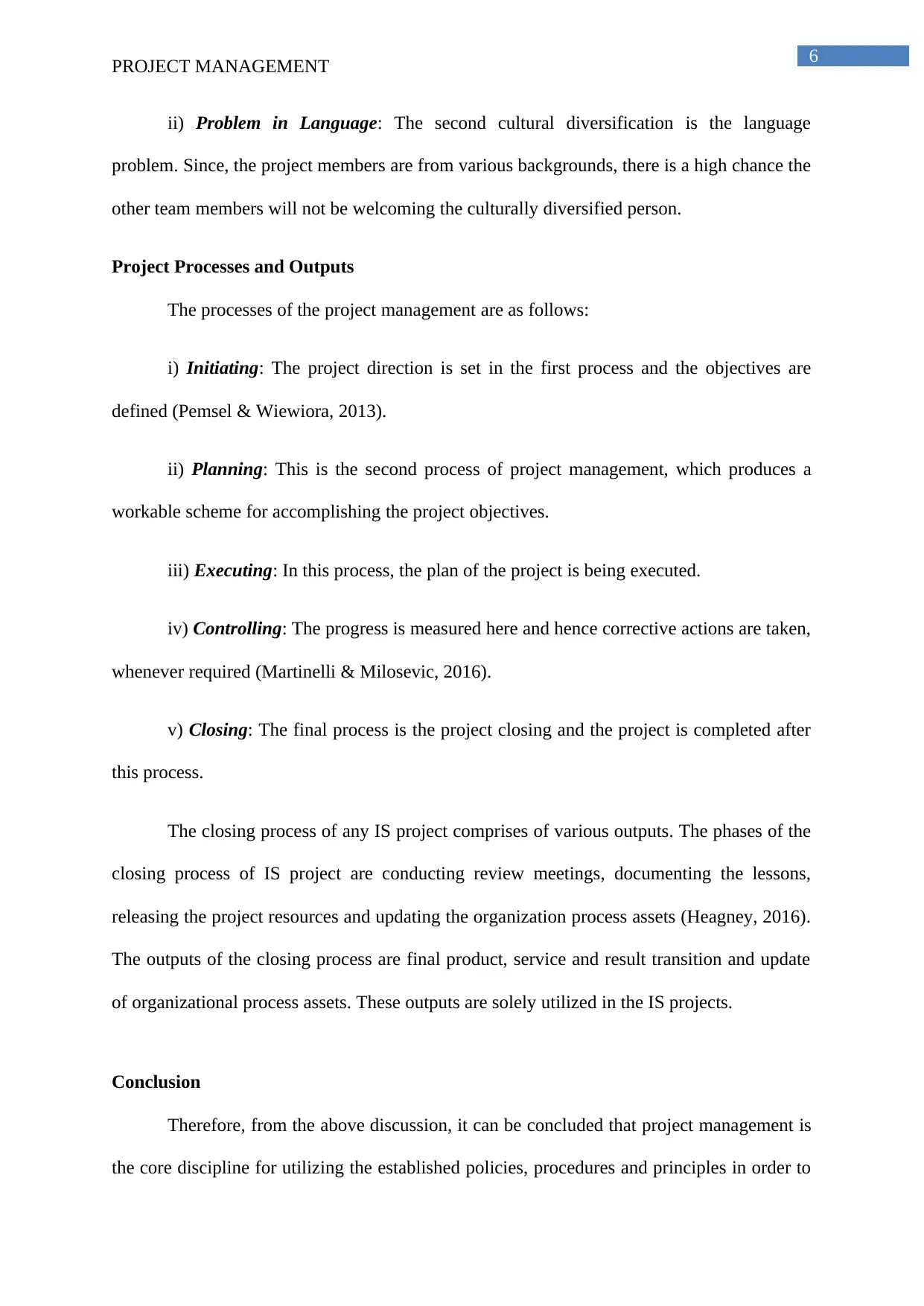
6
PROJECT MANAGEMENT
ii) Problem in Language: The second cultural diversification is the language
problem. Since, the project members are from various backgrounds, there is a high chance the
other team members will not be welcoming the culturally diversified person.
Project Processes and Outputs
The processes of the project management are as follows:
i) Initiating: The project direction is set in the first process and the objectives are
defined (Pemsel & Wiewiora, 2013).
ii) Planning: This is the second process of project management, which produces a
workable scheme for accomplishing the project objectives.
iii) Executing: In this process, the plan of the project is being executed.
iv) Controlling: The progress is measured here and hence corrective actions are taken,
whenever required (Martinelli & Milosevic, 2016).
v) Closing: The final process is the project closing and the project is completed after
this process.
The closing process of any IS project comprises of various outputs. The phases of the
closing process of IS project are conducting review meetings, documenting the lessons,
releasing the project resources and updating the organization process assets (Heagney, 2016).
The outputs of the closing process are final product, service and result transition and update
of organizational process assets. These outputs are solely utilized in the IS projects.
Conclusion
Therefore, from the above discussion, it can be concluded that project management is
the core discipline for utilizing the established policies, procedures and principles in order to
PROJECT MANAGEMENT
ii) Problem in Language: The second cultural diversification is the language
problem. Since, the project members are from various backgrounds, there is a high chance the
other team members will not be welcoming the culturally diversified person.
Project Processes and Outputs
The processes of the project management are as follows:
i) Initiating: The project direction is set in the first process and the objectives are
defined (Pemsel & Wiewiora, 2013).
ii) Planning: This is the second process of project management, which produces a
workable scheme for accomplishing the project objectives.
iii) Executing: In this process, the plan of the project is being executed.
iv) Controlling: The progress is measured here and hence corrective actions are taken,
whenever required (Martinelli & Milosevic, 2016).
v) Closing: The final process is the project closing and the project is completed after
this process.
The closing process of any IS project comprises of various outputs. The phases of the
closing process of IS project are conducting review meetings, documenting the lessons,
releasing the project resources and updating the organization process assets (Heagney, 2016).
The outputs of the closing process are final product, service and result transition and update
of organizational process assets. These outputs are solely utilized in the IS projects.
Conclusion
Therefore, from the above discussion, it can be concluded that project management is
the core discipline for utilizing the established policies, procedures and principles in order to
Paraphrase This Document
Need a fresh take? Get an instant paraphrase of this document with our AI Paraphraser
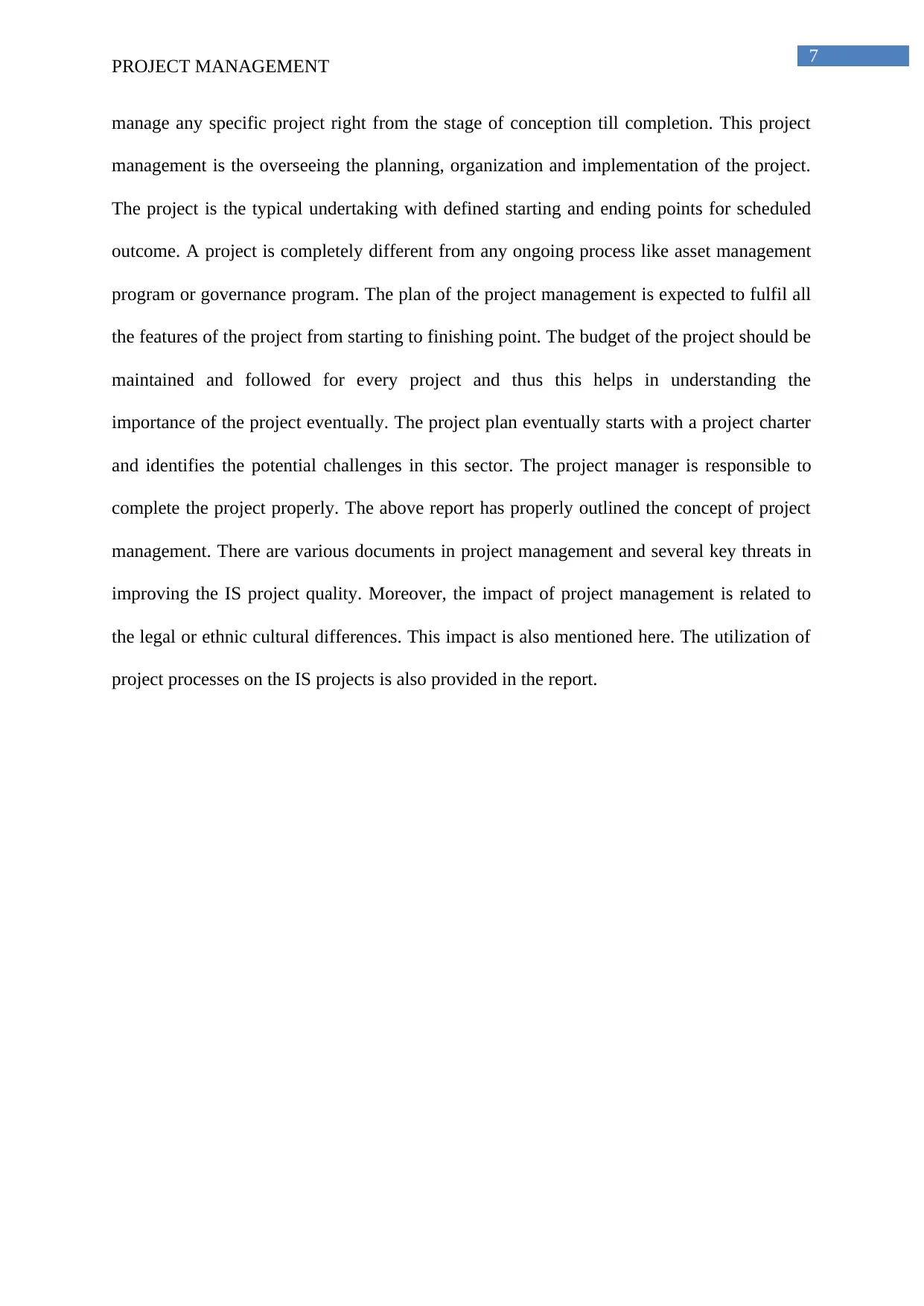
7
PROJECT MANAGEMENT
manage any specific project right from the stage of conception till completion. This project
management is the overseeing the planning, organization and implementation of the project.
The project is the typical undertaking with defined starting and ending points for scheduled
outcome. A project is completely different from any ongoing process like asset management
program or governance program. The plan of the project management is expected to fulfil all
the features of the project from starting to finishing point. The budget of the project should be
maintained and followed for every project and thus this helps in understanding the
importance of the project eventually. The project plan eventually starts with a project charter
and identifies the potential challenges in this sector. The project manager is responsible to
complete the project properly. The above report has properly outlined the concept of project
management. There are various documents in project management and several key threats in
improving the IS project quality. Moreover, the impact of project management is related to
the legal or ethnic cultural differences. This impact is also mentioned here. The utilization of
project processes on the IS projects is also provided in the report.
PROJECT MANAGEMENT
manage any specific project right from the stage of conception till completion. This project
management is the overseeing the planning, organization and implementation of the project.
The project is the typical undertaking with defined starting and ending points for scheduled
outcome. A project is completely different from any ongoing process like asset management
program or governance program. The plan of the project management is expected to fulfil all
the features of the project from starting to finishing point. The budget of the project should be
maintained and followed for every project and thus this helps in understanding the
importance of the project eventually. The project plan eventually starts with a project charter
and identifies the potential challenges in this sector. The project manager is responsible to
complete the project properly. The above report has properly outlined the concept of project
management. There are various documents in project management and several key threats in
improving the IS project quality. Moreover, the impact of project management is related to
the legal or ethnic cultural differences. This impact is also mentioned here. The utilization of
project processes on the IS projects is also provided in the report.
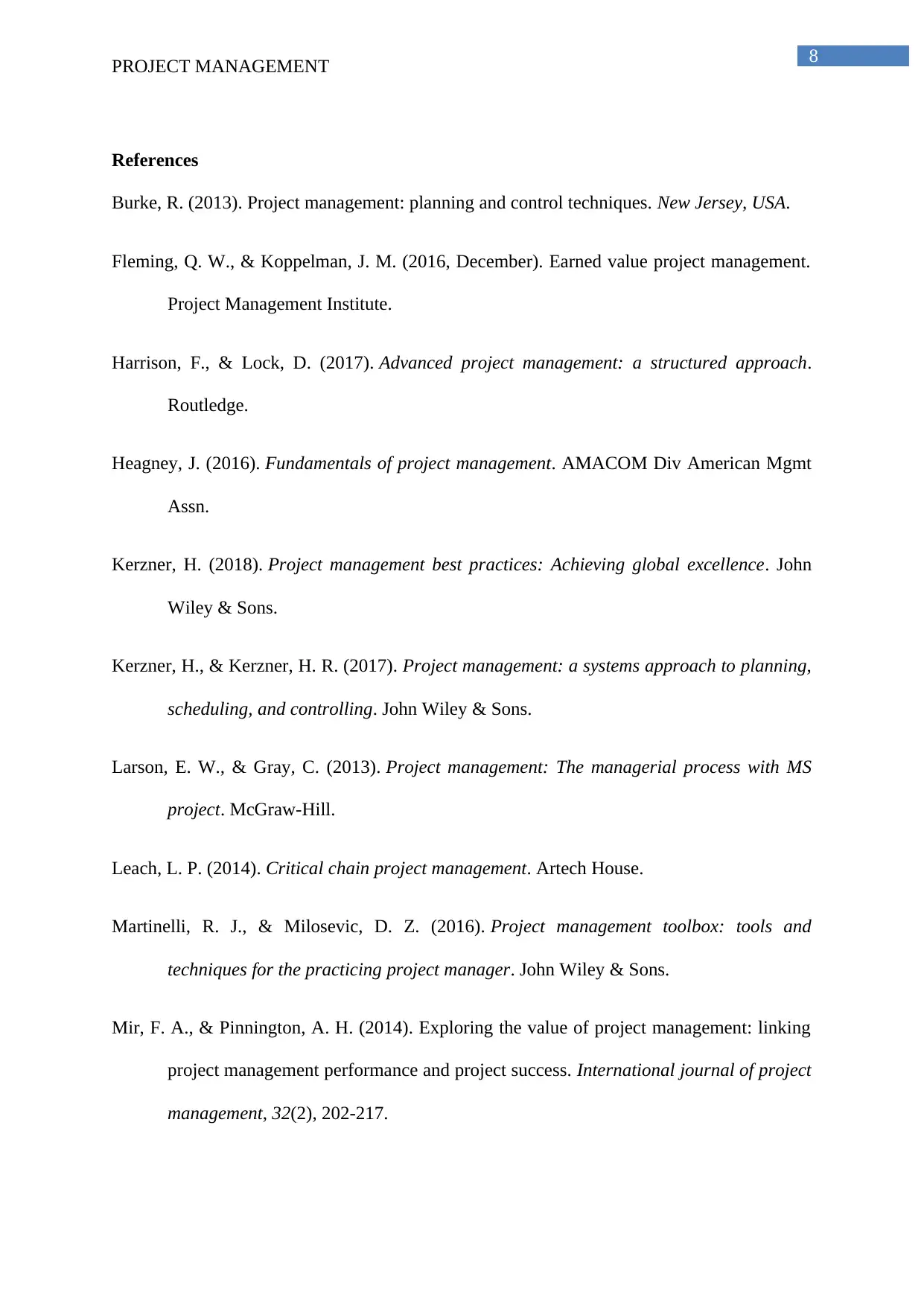
8
PROJECT MANAGEMENT
References
Burke, R. (2013). Project management: planning and control techniques. New Jersey, USA.
Fleming, Q. W., & Koppelman, J. M. (2016, December). Earned value project management.
Project Management Institute.
Harrison, F., & Lock, D. (2017). Advanced project management: a structured approach.
Routledge.
Heagney, J. (2016). Fundamentals of project management. AMACOM Div American Mgmt
Assn.
Kerzner, H. (2018). Project management best practices: Achieving global excellence. John
Wiley & Sons.
Kerzner, H., & Kerzner, H. R. (2017). Project management: a systems approach to planning,
scheduling, and controlling. John Wiley & Sons.
Larson, E. W., & Gray, C. (2013). Project management: The managerial process with MS
project. McGraw-Hill.
Leach, L. P. (2014). Critical chain project management. Artech House.
Martinelli, R. J., & Milosevic, D. Z. (2016). Project management toolbox: tools and
techniques for the practicing project manager. John Wiley & Sons.
Mir, F. A., & Pinnington, A. H. (2014). Exploring the value of project management: linking
project management performance and project success. International journal of project
management, 32(2), 202-217.
PROJECT MANAGEMENT
References
Burke, R. (2013). Project management: planning and control techniques. New Jersey, USA.
Fleming, Q. W., & Koppelman, J. M. (2016, December). Earned value project management.
Project Management Institute.
Harrison, F., & Lock, D. (2017). Advanced project management: a structured approach.
Routledge.
Heagney, J. (2016). Fundamentals of project management. AMACOM Div American Mgmt
Assn.
Kerzner, H. (2018). Project management best practices: Achieving global excellence. John
Wiley & Sons.
Kerzner, H., & Kerzner, H. R. (2017). Project management: a systems approach to planning,
scheduling, and controlling. John Wiley & Sons.
Larson, E. W., & Gray, C. (2013). Project management: The managerial process with MS
project. McGraw-Hill.
Leach, L. P. (2014). Critical chain project management. Artech House.
Martinelli, R. J., & Milosevic, D. Z. (2016). Project management toolbox: tools and
techniques for the practicing project manager. John Wiley & Sons.
Mir, F. A., & Pinnington, A. H. (2014). Exploring the value of project management: linking
project management performance and project success. International journal of project
management, 32(2), 202-217.
⊘ This is a preview!⊘
Do you want full access?
Subscribe today to unlock all pages.

Trusted by 1+ million students worldwide
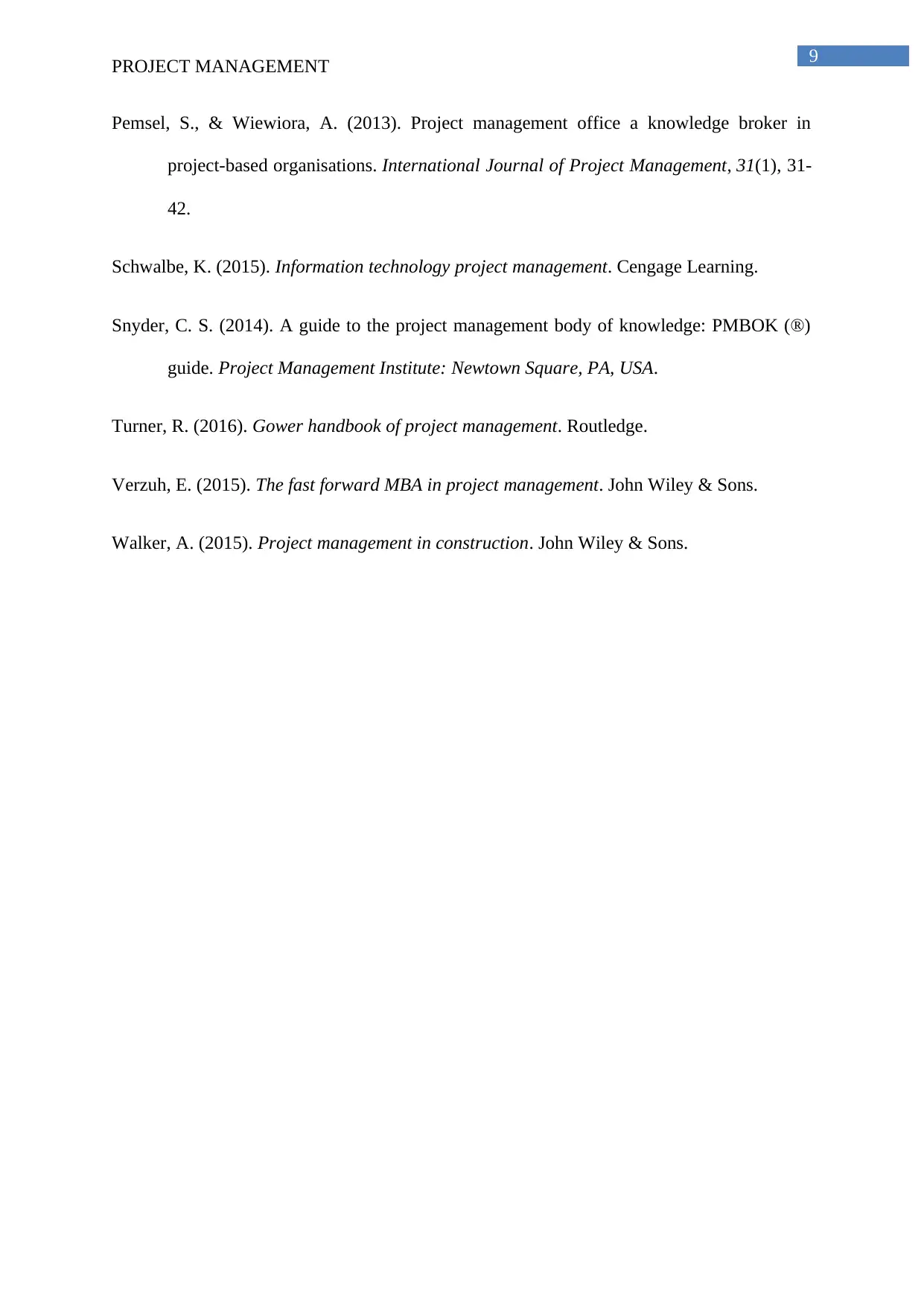
9
PROJECT MANAGEMENT
Pemsel, S., & Wiewiora, A. (2013). Project management office a knowledge broker in
project-based organisations. International Journal of Project Management, 31(1), 31-
42.
Schwalbe, K. (2015). Information technology project management. Cengage Learning.
Snyder, C. S. (2014). A guide to the project management body of knowledge: PMBOK (®)
guide. Project Management Institute: Newtown Square, PA, USA.
Turner, R. (2016). Gower handbook of project management. Routledge.
Verzuh, E. (2015). The fast forward MBA in project management. John Wiley & Sons.
Walker, A. (2015). Project management in construction. John Wiley & Sons.
PROJECT MANAGEMENT
Pemsel, S., & Wiewiora, A. (2013). Project management office a knowledge broker in
project-based organisations. International Journal of Project Management, 31(1), 31-
42.
Schwalbe, K. (2015). Information technology project management. Cengage Learning.
Snyder, C. S. (2014). A guide to the project management body of knowledge: PMBOK (®)
guide. Project Management Institute: Newtown Square, PA, USA.
Turner, R. (2016). Gower handbook of project management. Routledge.
Verzuh, E. (2015). The fast forward MBA in project management. John Wiley & Sons.
Walker, A. (2015). Project management in construction. John Wiley & Sons.
1 out of 10
Related Documents
Your All-in-One AI-Powered Toolkit for Academic Success.
+13062052269
info@desklib.com
Available 24*7 on WhatsApp / Email
![[object Object]](/_next/static/media/star-bottom.7253800d.svg)
Unlock your academic potential
Copyright © 2020–2025 A2Z Services. All Rights Reserved. Developed and managed by ZUCOL.




![PPMP20009 Project Portfolio: Week [Week Number] Learning Analysis](/_next/image/?url=https%3A%2F%2Fdesklib.com%2Fmedia%2Fimages%2Fin%2F5f8e46899eaa45618c192ef9551fb273.jpg&w=256&q=75)